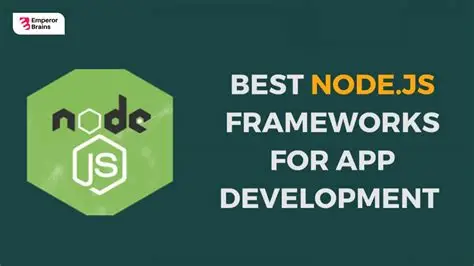Top Node.js Frameworks for Backend Development

One of the most significant issues that web developers faced in the past was that JavaScript frameworks were confined to client-side scripting. Prior to 2009, there were a few server-side JavaScript frameworks.
Node.js, which debuted in 2009, transformed web development by allowing developers to utilize JavaScript for both client-side and server-side programming, allowing them to use a single language throughout the application stack.
The advantages were rapid and thrilling, and Node.js emerged as the best platform for bespoke web development.
In this blog, we examine the top frameworks that Node.js app development company rely on, considering factors such as ease of use, speed, complexity, popularity, and community support.
What are NodeJS Frameworks?
NodeJS frameworks are collections of libraries, templates, and tools created on top of the Node platform. These frameworks provide a fundamental structure for applications, including templates, routes, and middleware, therefore streamlining the development process. As previously said, there are several NodeJS frameworks available, each with its own distinct features, strengths, and shortcomings.
Real-time frameworks in NodeJS make it easier to construct a critical facet of current web development, including chat, alerts, data streaming, and more. Interestingly, Node.js is also the preferred option for the top mobile application development company in the USA.
7 Best NodeJS Frameworks
1. Express
Express is the most widely used and lightweight web framework for Node.js. Express is intended to facilitate backend application development by providing a comprehensive set of capabilities such as error handling, routing, middleware, and templating.
Key Features:
- Fundamental features: Express’s collection of fundamental features simplifies and speeds up the development process. It’s simple to learn and contains a number of NodeJS capabilities such as routing and middleware.
- Middleware integration: Express enables developers to include crucial functionality into their applications through the use of middleware.
- MVC design: Express’s MVC design enables the division of a large, complex program into smaller, more manageable portions, making it easier to comprehend and manage.
2. Fastisy
Fastify is an Express-based, lightweight NodeJS web framework. It focuses on low overhead and a responsive user experience.
Key Features:
- Lightweight: Fastify is a lightweight framework that provides more functionality with less overhead.
- Schema-based: Fastify proposes the JSON format for route validation and serialization.
- Easy to use: Fastify’s API is simple to understand and use for production-ready projects.
3. NestJS
NestJS is a NodeJS progressive framework for developing server-side apps using JavaScript and TypeScript. NestJS is a modular design that allows developers to construct large applications by grouping components into independent modules, ensuring reusability and maintainability across several areas of the program.
Key Features:
- Modular Design: NestJS provides a modular design that allows for the isolation of application pieces and layers, resulting in better maintainability and scalability.
- Varied Support: NestJS supports TypeScript and enables developers to use JavaScript for coding.
- CLI tool: The Nest CLI makes it easy to set up and create apps using simple commands.
4. Socket.IO
Socket.IO is a NodeJS framework based on WebSockets that supports real-time communication between client and server. Socket.IO is event-driven and works with older browsers and environments.
Key Features:
- Seamless Reconnection: Socket.IO helps re-establish the connection between the client and server.
- Old browser support: Socket.IO has a fallback HTTP long-polling method that makes it compatible with older browsers.
- Packet buffering: In the case of a disconnect, Socket.IO buffers packets that are transmitted to the client upon reconnecting, ensuring that no data is lost.
5. Feathers.js
Feathers.js is an Express-based web framework that makes it easy to create scalable and dependable applications. Feathers.js supports a variety of databases and is compatible with all frontend technologies, including iOS, Android, and React Native.
Key Features:
- Feathers.js supports a microservices architecture, which allows you to divide an application into smaller, independent services that can be deployed individually.
- Realtime Support: Feathers.js leverages Socket.IO, which enables the building of real-time applications.
6. Meteor.js
Meteor.js is a full-stack Node.js framework designed exclusively for JavaScript, making it easy to construct real-time functionality thanks to its simple API.
Key Features:
- RPC API: The Remote Procedure Call (RPC) system: Meteor.js’ RPC API methods provide simple frontend and backend interaction.
- Built-in accounts: The login and account package is ready to use and does not require developers to construct their own authentication system.
- Pub/Sub approach: The Pub/Sub approach allows for the easy introduction of real-time functionality through publications and subscriptions.
7. Sails
Sails is a real-time NodeJS MVC framework based on Express. Sails offers a versatile routing system and built-in real-time communication capabilities.
Key Features:
- ORM (Object Relational Mapping): Sails has a basic data access layer that allows you to retrieve data from any database.
- WebSockets Support: It requires no additional code. Sails enables real-time feature development over WebSockets without the need to create extra code.
- Access REST APIs: Sails provides REST API blueprints that can be generated using the sails generate api command.
How to choose the Best NodeJS framework
Project Requirements
Understand your project’s needs, including real-time functionality, scalability, and complexity. For example, you may explore utilizing Express as a backend server by leveraging Socket.IO to provide real-time communication.
Community Support and Documentation
A framework with an active community can benefit you in a variety of ways. A dynamic community suggests a well-maintained and constantly improving structure. If you run into problems when building your application, you may turn to the community for tried-and-true advice and ideas.
Common Limitations
Each framework has its own limits. It is critical to examine the restrictions and choices you may have to make while comparing different frameworks.
Conclusion
Node.js frameworks simplify the creation of online and mobile apps due to their tremendous capabilities. With ever-changing technology, it is critical to carefully consider our project requirements and resource availability while selecting the ideal framework for the job.



